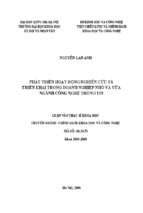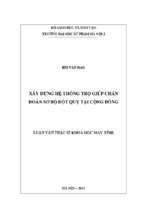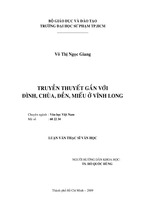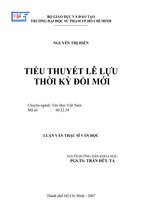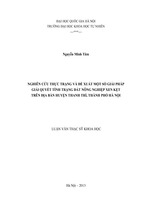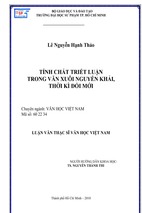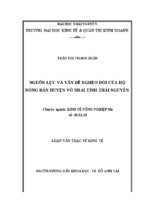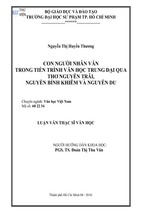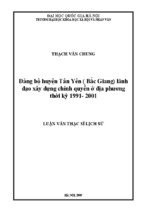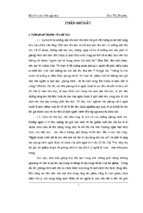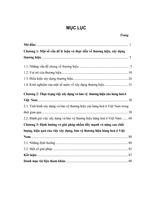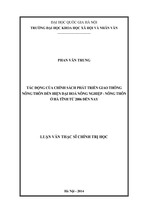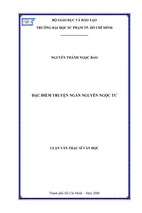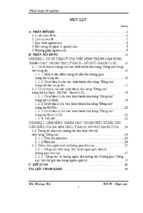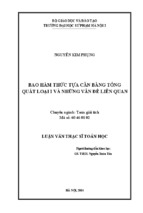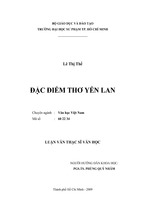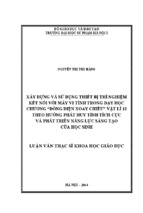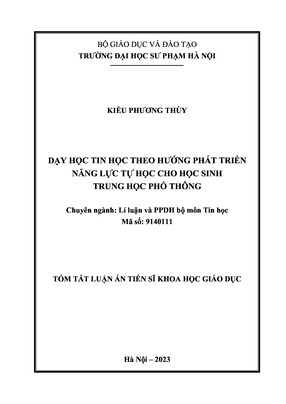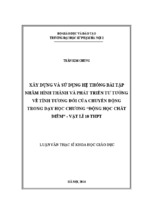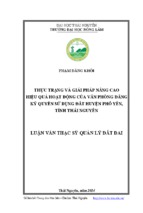VIETNAM NATIONAL UNIVERSITY, HANOI
UNIVERSITY OF LANGUAGES AND INTERNATIONAL STUDIES
FACULTY OF POST-GRADUATE STUDIES
-----------------
NGUYEN THI BICH THUY
ENGLISH READING STRATEGY USE
BY UNIVERSITY STUDENTS IN VIETNAM
(Nghiên cứu chiến lược đọc tiếng Anh
của sinh viên đại học ở Việt Nam)
A Dissertation Submitted in Partial Fulfilment of the
Requirements for the Degree of Doctor of Philosophy
[
Hanoi - 2018
VIETNAM NATIONAL UNIVERSITY, HANOI
UNIVERSITY OF LANGUAGES AND INTERNATIONAL STUDIES
FACULTY OF POST-GRADUATE STUDIES
-----------------
NGUYEN THI BICH THUY
ENGLISH READING STRATEGY USE
BY UNIVERSITY STUDENTS IN VIETNAM
(Nghiên cứu chiến lược đọc tiếng Anh
của sinh viên đại học ở Việt Nam)
Major: English Language Teaching Methodology
Code: 9140231.01
A Dissertation Submitted in Partial Fulfilment of the
Requirements for the Degree of Doctor of Philosophy
Supervisors: 1. Dr. Hoang Thi Xuan Hoa
2. Assoc. Prof. Dr. Lam Quang Dong
[
Hanoi - 2018
STATEMENT OF AUTHORSHIP
The dissertation titled “English Reading Strategy Use by University Students in
Vietnam” has been submitted in partial fulfillment of requirements for the Degree
of Doctor of Philosophy.
I, the undersigned, hereby declare that I am the sole author of this dissertation. I
have fully acknowledged and referred the ideas of work of others, whether
published or unpublished, in my dissertation.
The dissertation does not contain work extracted from theses, dissertations or
research papers previously presented for another degree or diploma at this or any
other universities.
Signed
Nguyen Thi Bich Thuy
i
ACKNOWLEDGMENTS
Comment [G1]: Deleted:E
Writing this dissertation has had a big impact on me. The research journey would
never have been possible without the involvement of many individuals and
groups, to whom my grateful acknowledgments are extended.
Comment [G2]: Deleted:e
First and foremost, I would like to express my heartfelt gratitude to my
supervisors, Dr. Hoàng Thị Xuân Hoa, and Assoc. Prof. Dr. Lâm Quang Đông,
who gave me opportunities, encouragement, and invaluable guidance throughout
the entire journey of my doctoral study including this dissertation. Without their
intellectual mentoring, I would never have completed this dissertation with pride
and satisfaction.
My sincere thanks go to Dr. Huỳnh Anh Tuấn, the Dean, and all the lecturers as
well as the staff members of the Faculty of Postgraduate Studies, University of
Languages and International Studies (ULIS), Vietnam National University (VNU)
for their precious help, constructive feedback, and warm support during my study
time.
Thanks are also due to the Managing Board and my colleagues from the College
of Techniques, Economics and Trade (CTET) and those from other universities
who accompanied me during my study.
Comment [G3]: Inserted: rom
Comment [G4]: Deleted:o
I wish to express my gratitude to my research participants for their help and
willingness to participate in this research. The results I have achieved today
partially belong to them.
Last but not least, my heart goes to my loving Family, whose boundless love,
continuous support, encouragement, and exceptional patience have given me the
strength and motivation to complete this work. This dissertation is dedicated to
my Parents, my Husband and my two Children.
Thank you very much, everyone!
Nguyễn Thị Bích Thủy
2018
ii
ABSTRACT
The present study investigated the strategy use by Vietnamese university students
when they read general English materials. It also examined if there were
differences in the use of reading strategies between students who learned English
as a compulsory subject at university (EFL students) and those who used English
as a medium of instruction in the university (EMI students). The research also
aimed to find out how the factors of gender, academic majors, English learning
time, English learning/English reading enjoyment, self-rated English/English
reading proficiency, self-perception of the importance of being a proficient
English reader related to the students‟ reading strategy use.
Nine hundred and sixty-three Vietnamese students from six universities in the
North of Vietnam participated in the study. The main data of the research were
collected by means of a questionnaire, adapted from Oxford's (2013) SelfStrategic Regulation Reading Strategy Model. In addition, qualitative data from
semi-structured interviews with fifteen students chosen from the sample were also
analyzed to support the main evidence.
Comment [G5]: Inserted: -
The research findings revealed that the Vietnamese students were medium reading
strategy users. EMI students reported to use more strategies and at a higher
frequency level than their EFL counterparts. The results of the study indicated that
the Vietnamese university students employed the reading strategies differently
according to their personal characteristics, namely academic majors, enjoyment of
English learning and reading English materials, and self-rated English and English
reading proficiency.
Though there were not statistically significant differences, students of different
gender, English learning time and self-perception levels of the importance of
being a proficient English reader used strategies differently as well.
Based on the research results several pedagogical implications and suggestions for
further research were also presented.
iii
TABLE OF CONTENTS
STATEMENT OF AUTHORSHIP ........................................................................i
ACKNOWLEDGMENTS ..................................................................................... ii
ABSTRACT ........................................................................................................... iii
TABLE OF CONTENTS.......................................................................................iv
LIST OF ABBREVIATIONS ............................................................................. vii
LIST OF FIGURES AND GRAPHS ..................................................................... x
INTRODUCTION ................................................................................................... 1
1. Background to the study..................................................................................... 1
2. Purpose of the study ............................................................................................ 3
3. Scope of the study ................................................................................................ 4
4. Significance of the study ..................................................................................... 4
5. Structure of the study ......................................................................................... 5
CHAPTER ONE: LITERATURE REVIEW ....................................................... 7
1.1. Reading ............................................................................................................. 7
1.1.1. Psycholinguistic model............................................................................. 7
1.1.2. Social constructivist model .................................................................... 12
1.1.3. Self-strategic regulation model .............................................................. 14
1.2. Reading strategies .......................................................................................... 17
1.2.1. Definitions and characteristics of reading strategies .............................. 17
1.2.2. Classifications of reading strategies ....................................................... 19
1.3. Previous studies on reading strategies ......................................................... 29
1.3.1. Frequencies and types of students‟ reading strategy use........................ 29
1.3.2. Successful and unsuccessful readers‟ reading strategy use .................... 33
1.3.3. Strategies used by English as a second (ESL) and English as a foreign
language (EFL) readers ...................................................................................... 37
1.3.4. Factors affecting the use of reading strategies ....................................... 39
1.3.5. Strategies used in reading texts of different genres................................ 42
1.5. Chapter summary....................................................................................... 51
CHAPTER TWO: RESEARCH METHODOLOGY ....................................... 54
2.1. Common methods applied in reading strategy research ............................ 54
iv
2.1.1. Questionnaires ........................................................................................ 56
2.1.2. Oral interviews ....................................................................................... 57
2.1.3. Verbal report ........................................................................................... 59
2.1.4. Mixed methods ....................................................................................... 62
2.2. Research methods of the present study ........................................................ 63
2.2.1. Questionnaire .......................................................................................... 64
2.2.2. Semi-structured interview ...................................................................... 66
2.2.3. The reading text ...................................................................................... 66
2.3. The pilot study ................................................................................................ 67
2.3.1. Participants ............................................................................................. 67
2.3.2. Procedures .............................................................................................. 67
2.4. The main study ............................................................................................... 69
2.4.1. The participants ...................................................................................... 69
2.4.2. Instruments ............................................................................................. 76
2.4.3. Data collection and analysis procedures ................................................ 76
2.5. Chapter summary .......................................................................................... 84
CHAPTER THREE: FINDINGS AND DISCUSSIONS ................................... 87
3.1. Findings ........................................................................................................... 87
3.1.1. Question 1. What strategies are used by students in their reading
General English (GE) texts? .............................................................................. 87
3.1.2. Question 2. To what extent is the use of reading strategies by students
who learn English as a compulsory subject (EFL students) different from that
by students who use English as a medium of instruction in their universities
(EMI students)?.................................................................................................. 93
3.1.3. Question 3. How do the factors of gender, academic majors, English
learning time, English learning/English reading enjoyment, self-rated
English/English reading proficiency, self-perception of the importance of being
a proficient English reader relate to students‟ reading strategy use? ................ 99
3.1.4. The predictive relationship among the students' strategy category use
and independent variables................................................................................ 121
3.2. Discussion ...................................................................................................... 126
v
3.2.1. Question 1. What strategies are used by university students in their
reading General English (GE) texts? ............................................................... 126
3.2.2. Question 2. To what extent is the use of reading strategies by students
who learn English as a compulsory subject (EFL students) different from that
by students who use English as a medium of instruction in their universities
(EMI students)?................................................................................................ 133
3.2.3. Question 3. How do the factors of gender, academic majors, English
learning time, English learning/English reading enjoyment, self-rated
English/English reading proficiency, self-perception of the importance of being
a proficient English reader relate to the students‟ reading strategy use?......... 137
3.3. Chapter summary ........................................................................................ 149
CONCLUSIONS AND RECOMMENDATIONS ............................................ 151
1. Summary of the research findings................................................................. 151
2. Pedagogical implications ................................................................................ 155
2.1. For educational administrators ................................................................ 155
2.2. For teachers of English ............................................................................ 156
2.3. For students ............................................................................................. 158
2.4. For English textbook writers ................................................................... 158
3. Limitations ....................................................................................................... 159
4. Suggestions for further research ................................................................... 159
REFERENCES .................................................................................................... 162
APPENDICES ..................................................................................................... 188
vi
LIST OF ABBREVIATIONS
AFFEC
Affective Strategies
COG
Cognitive Strategies
EFL
English as a Foreign Language
EMI
English as a Medium of Instruction
ESL
English as a Second Language
FL
Foreign Language
GE
General English
L2
Second Language
M
Mean Score
MARSI
Metacognitive Awareness of Reading Strategy Inventory
META
Metastrategies
SCD
Strategies for Coping with Difficulties
SCT
Strategies for Comprehending the Text
S.D
Standard Deviation
SILL
Strategy Inventory for Language Learning
SOC
Socio-cultural Interactive Strategies
SORS
Survey of Reading Strategies
SPSS
Statistical Package for the Social Sciences
S2R
Self-strategic Regulation
WHS
While-reading Strategies
ZPD
Zone of Proximal Development
Comment [G6]: Inserted: r
Comment [G7]: Inserted: f
Comment [G8]: Deleted:t
vii
LIST OF TABLES
Table 2.1. Gender of Participants.............................................................................. 71
Table 2.2. Academic Majors of Participants ............................................................. 71
Table 2.3. Participants‟ English learning time .......................................................... 72
Table 2.4. Participants‟ English Learning Enjoyment .............................................. 72
Table 2.5. Participants‟ Enjoyment of Reading English Texts ................................. 73
Table 2.6. Participants‟ Experiences in Reading Strategy Training ......................... 73
Table 2.7. Participants‟ Self-rated English Proficiency ............................................ 74
Table 2.8. Participants‟ Self-rated English Reading Proficiency ............................. 74
Table 2.9. Evaluation of the Importance of English Reading Proficiency ............... 75
Comment [G9]: Inserted: f
Table 2.10. Participants‟ Strategy Training Belief ................................................... 75
Comment [G10]: Deleted:n
Table 2.11. Interviewees' Information ...................................................................... 78
Table 2.12. Frequency Scale Delineated by Oxford (1990) ..................................... 80
Table 2.13. The Sample of Coding Qualitative Data ................................................ 83
Table 2.14. The Research Procedures ....................................................................... 85
Table 3.1. Strategies Used by Participants when Reading GE Texts ....................... 88
Table 3.2. Participants‟ Use of Each Strategy Category........................................... 91
Table 3.3. Participants‟ Use of Cognitive Strategies ................................................ 91
Table 3.4. Participants‟ Use of Affective Strategies ................................................. 92
Table 3.5. Participants‟ Use of Socio-Cultural Interactive Strategies ...................... 92
Table 3.6. Participants‟ Use of Metastrategies ......................................................... 92
Table 3.7. Overall Strategy Use by EFL and EMI Students ..................................... 93
Table 3.8. Strategy Use by Categories by EFL and EMI Students ........................... 94
Table 3.9. Tests of between Subject Effects ............................................................. 94
Table 3.10. Individual Strategies Used by EFL vs EMI Students ............................ 95
Table 3.11. Sample t-test of Individual Strategies Used between EFL & EMI
Students.............................................................................................................. 97
Table 3.12. Overall Strategy Use by Gender ............................................................ 99
Table 3.13. Use of each Category Strategy by Gender ............................................. 99
Table 3.14. Five Most and Least Used Strategies by Males and Females .............. 100
viii
Comment [G11]: Inserted: The s
Comment [G12]: Deleted:S
Table 3.15. Differences in Reading Strategy Use between Males and Females .... 101
Table 3.16. Participants‟ Overall Strategy Use by Academic Majors .................... 103
Table 3.17. Use of Strategy Category by Academic Major Groups ....................... 104
Table 3.18. ANOVA F-Test on Effect of Academic Majors on Students‟ Reading
Strategy Use ..................................................................................................... 105
Table 3.19. Test of Homogeneity of Variances on Individual Strategy Use .......... 106
Table 3.20. Participants‟ Overall Strategy Use by English Learning Time ........... 108
Table 3.21. Use of Each Strategy Category by Students of Different English
Learning Time ................................................................................................. 108
Table 3.22. Participants‟ Overall Strategy Use by Levels of English Learning
Enjoyment ........................................................................................................ 110
Table 3.23. Participants‟ Use of Each Strategy Category between Levels of
English Learning Enjoyment ........................................................................... 110
Table 3.24. Participants‟ Overall Strategy Use by Levels of English Reading
Enjoyment ........................................................................................................ 112
Table 3.25. Use of Reading Strategy Categories by Students of Different Levels of
English Reading Enjoyment ............................................................................ 112
Table 3.26. Participants‟ Overall Strategy Use by Self-rated English Proficiency 113
Table 3.27. Participants‟ Use of Each Strategy Category by Levels of Self-rated
English Proficiency.......................................................................................... 114
Table 3.28. Participants‟ Overall Strategy Use by Levels of Self- rated English
Reading Proficiency ........................................................................................ 115
Table 3.29. Participants‟ Use of Strategy Category by Levels of Self-rated English
Reading Proficiency ........................................................................................ 116
Table 3.30. The Most and the Least Frequently Used Strategies by Self-rated
Good and Poor Participants ............................................................................. 117
Table 3.31. Participants‟ Overall Strategy Use by Self-perception of the
Importance of Being a Proficient English Reader ........................................... 119
Table 3.32. Use of Strategy Category by Students of Different Levels of Selfperception of the Importance of Being a Proficient English Reader ............... 120
Table 3.33. Model Summary of Metastrategy Category Use and Independent
Variables .......................................................................................................... 122
ix
Table 3.34. Coefficients between Metastrategy Category Use and Independent
Variables .......................................................................................................... 122
Table 3.35. Model Summary of Cognitive Strategy Category Use and Independent
Variables .......................................................................................................... 123
Table 3.36. Coefficients between Cognitive Category Use and Independent
Variables .......................................................................................................... 124
Table 3.37. Model Summary of Affective Strategy Category Use and Independent
Variables .......................................................................................................... 124
Table 3.38. Coefficients between Affective Category Use and Independent
Variables .......................................................................................................... 125
Table 3.39. Model Summary of Socio-cultural Interactive Strategy Category Use
and Independent Variables .............................................................................. 125
LIST OF FIGURES AND GRAPHS
Figure 1.1. Reading Process by Davies and Whitney (1989) ..................................... 8
Figure 1.2. Bottom-up Process by Cambourne (1991) ............................................... 9
Figure 1.3. Top-down Process by Cambourne (1991) ................................................ 9
Figure 1.4. Bernhardt's (1986) Social Constructivist Model .................................... 13
Figure 1.5. S2R Classification of Reading Strategies (Oxford, 2013) ..................... 50
Figure 2.1. Data Collection Procedures based on Cresswell‟s Model (2003) .......... 77
Graph 3.1. Impact of the Four Predictors on the Participants‟ Frequent Use of the
Reading Strategy Categories ........................................................................... 126
x
INTRODUCTION
1. Background to the study
Reading, as a receptive skill, has long been regarded as a prerequisite for
foreign language acquisition (Aebersold & Field, 1997), since it functions as an
essential source of input for other skills (listening, speaking, and writing) to
construct language proficiency. Being the essence of reading (Durkin, 1993),
reading comprehension is one of the most important factors in English language
learning for all students because it provides the basis for a substantial amount of
learning in education (Alvermann & Earle, 2003; Martin, et al., 2008). Therefore,
reading also plays a vital role in academic development, particularly when
learners have to work over a huge amount of foreign language materials for their
own specialist subjects (McDonough & Shaw, 2013). It is thought to be the
primary means for gaining access to various sources of information, providing the
basis for “synthesis and critical evaluation skills” (Celce-Murcia, 2001, p. 187).
Furthermore, reading also facilitates readers to develop themselves in various
situations such as general knowledge, writing skills, and spelling (Ahmadi &
Hairul, 2012; Harmer, 2007).
Because of its crucial importance reading in any language is demanding
(Czicko, et al. as cited in Kern, 1997). In addition, reading in a second or foreign
language can place even greater demands on the processes involved in reading due
to the reader‟s incomplete linguistic or cultural knowledge (Bouvet, 2000).
Students nowadays need not only to acquire knowledge and theories from English
reading materials but also to read many English books, periodicals or magazines
for the absorption of new knowledge and information. Good English reading
ability can be helpful to effectively obtain the current information as necessary.
Especially, in our modern society of internationalization and globalization it is in
urgent need of English talented person. Strengthening English reading ability is
necessary for students to develop other English skills as well as to get knowledge
for their study major. However, though students have to read a large volume of
academic texts in English many of them entering university education are
unprepared for the reading demands placed on them (Dreyer & Nel, 2003).
1
Researchers and teachers have tried hard to find out possible ways to help
students read successfully in English, but there are many factors affecting
students‟ English reading proficiency such as text types, university and social
environments, students‟ intelligence, learning motivation, teaching methods, and
so on (Hsu, 2015). One of the most important factors is students‟ learning strategy
use, particularly their use of reading strategies. The best prevention of reading
difficulties is early intervention strategies (DeMoulin & Loye, 1999), as second or
foreign language readers can “compensate for a lack of English proficiency by
invoking interactive strategies, utilizing prior knowledge, and becoming aware of
their strategy choices” (Hudson as cited in Auerbach & Paxton, 1997, p. 238).
However, in the reality of English teaching and learning, most students
seem to be unfamiliar with the utilization of English reading strategies. They show
an inability to read selectively or to extract what is important for the purpose of
reading and discarding what is insignificant. Also, they often select ineffective
and inefficient strategies with little strategic intent (Wood, et al., 1998).
Consequently, their reading comprehension is reduced.
In their learning process, most students meet great challenges when dealing
with reading texts. They usually have difficulties in understanding the meaning of
the context and cannot complete the tasks, which makes them feel tired and do not
show enough interest in reading lessons or reading activities. However, reading
strategies help them in learning foreign languages and reading comprehension
(Ben-David, 2002). Though reading strategies used by efficient and inefficient
readers were different (Block, 1986; Shinghal, 2001), they help improve the
reading ability of both the proficient and less proficient readers (Ahmadi &
Pourhossein, 2012).
Those mentioned above have stimulated a noticeable growth in the number
of studies on reading strategies used in second and foreign language reading to
improve comprehension (Block, 1986; Menzoda de Hopkins & Mackay as cited in
Janzen & Stoller, 1998). However, research results were diverse. Many studies
revealed the significant correlation between reading strategy use and reading
comprehension performance (Oxford & Ehrman, 1995; Zane & Othman, 2013).
Some authors such as Anderson (1991), Baker and Boonkit (2004), and Yukselir
2
(2014) found out that high-proficiency and low-proficiency readers used more or
Comment [G13]: Inserted: the
less the same range of strategies at the nearly similar level of frequency. Other
studies indicated factors that affected readers' strategy use such as reader's
proficiency level, age, gender, motivation, learning style, career orientation,
culture, language teaching method, etc. (Gavriilidou & Psaltou-Joycey, 2009).
In the context of Vietnam, the Project “Teaching and Learning Foreign
Languages in the National Education System, period 2008 to 2020” launched by
the Vietnam Prime Minister shows the overall objectives that “by 2020, most
young Vietnamese graduates of professional secondary schools, colleges and
universities will have a good command of foreign language which enables them to
independently and confidently communicate, study and work in a multilingual and
multicultural environment of integration; to turn foreign languages into a strength
of Vietnamese to serve national industrialization and modernization” (Decision
No. 1400/QD-TTg). However, in such case, to the best knowledge of the
researcher, presently no comprehensive research has been done on the use of
reading strategies by university students in Vietnam, especially on the use of
reading strategies by students who learn English as a foreign language and those
who use English as a medium of instruction at the university, and on the factors
affecting their reading strategy use. Such the reality was actually the impetus for
this study, which intended to fill in the gap.
2. Purpose of the study
The primary purpose of the study was to explore the use of reading
strategies by Vietnamese university students when they read General English (GE)
texts. The study also attempted to examine if there are any differences in the use
of reading strategies between students who learn English as a compulsory subject
and those who use English as a medium of instruction in the university. In
addition, the study aimed to find out how the factors of gender, academic majors,
English
learning
time,
English
learning/reading
enjoyment,
self-rated
English/English reading proficiency, self-perception of the importance of being a
proficient English reader relate to students‟ reading strategy use. In order to
achieve these purposes, the research addressed the following questions:
3
Comment [G14]: Inserted: the
Question 1: What strategies are used by students in their reading General
English (GE) texts?
Question 2: To what extent is the use of reading strategies by students who
learn English as a compulsory subject (EFL students) different from that by
students who use English as a medium of instruction in their universities (EMI
students)?
Question 3: How do the factors of gender, academic majors, English
learning
time,
English
learning/English
reading
enjoyment,
self-rated
English/English reading proficiency, self-perception of the importance of being a
proficient English reader relate to the students‟ reading strategy use?
3. Scope of the study
This study investigates the use of reading strategies by non-English
majored students in universities in the North of Vietnam when they read general
English texts.
4. Significance of the study
Reading plays an essential role in English for academic purposes
(Aebersols & Field, 1997; McDonough & Shaw, 2003; Sengupta, 2002).
However, previous studies show that most university students today take a surface
approach to reading and learning (Biggs, 1998, p. 58). They usually consider text
information as isolated and unlinked facts, which leads to superficial retention of
material for examinations and does not promote understanding or long-term
retention of knowledge and information (Bowden & Marton, 2000, p.49). Hence
an investigation into students‟ reading strategy use in academic contexts may have
some implications for Vietnamese learners, teachers, textbook writers, and
education administrators to improve students‟ English reading proficiency
particularly and English learning in universities generally. The study is therefore
significant as follows:
Theoretically, by reviewing the literature related to the field of the study
the research has contributed to showing a comprehensive picture of theoretical
issues in the field of reading and reading strategies. The most updated and
4
appropriate theoretical framework guiding this research process was also
presented which might help other researchers in their future similar studies.
Methodologically, the study has verified the effectiveness of different
methods in conducting studies on reading strategy use. Specifically, it has
provided appropriate instruments to investigate readers' strategy use, especially in
the context of universities in Vietnam.
Comment [G15]: Inserted: '
The study is especially significant in the practice of English reading in
Comment [G16]: Deleted:'
particular and English learning in general in universities in Vietnam. First of all, it
has contributed to providing a comprehensive picture of Vietnamese university
students' reading strategy use when they read general English (GE) texts. The
study results show the types and frequencies of reading strategies students used
which might help both teachers and students define the way Vietnamese
university students deal with English reading comprehension. Secondly, a
comparison of the use of reading strategies between EFL and EMI students may
contribute to finding out the key to enhance students' reading performance.
Thirdly, the identification of how the factors of gender, academic majors, English
learning
time,
English
learning/English
reading
enjoyment,
self-rated
English/English reading proficiency, self-perception of the importance of being a
proficient English reader relate to students' strategy use would help teachers
understand how differently Vietnamese university students employ strategies
during their reading according to their personal identities. Consequently,
administrators and teachers may incorporate training on reading strategies in a
university English learning curriculum to help students improve their reading
comprehension, which then helps students much in completing their university
academic programs. Furthermore, the results of the study might be a significant
base to enable textbook writers design English texts in such a way that readers are
encouraged to elicit and apply as many appropriate strategies as possible to
improve their reading comprehension.
Comment [G17]: Inserted: a
Comment [G18]: Inserted: he t
5. Structure of the study
This study is organized into three main parts: Introduction, Contents, and
Conclusions and Recommendations.
Comment [G19]: Inserted: to
5
The Introduction describes the background and the purposes of the study
with the key research questions. The significance of the study is also presented.
The Contents consist of three chapters. Chapter One entitled Literature
Review provides comprehensive theoretical issues related to the field of the study.
The purpose of providing a review of the related literature is to show a conception
of reading and reading strategies by showing some most well-known reading
models and reading strategy taxonomies, which is followed by a critical review of
theoretical and empirical literature relevant to the purpose of the study. Especially,
the theoretical framework guiding the research is also presented. In addition,
previous studies related to reading strategies are demonstrated as well.
Chapter Two explains the research methodologies of the study including
the methodological considerations and procedures involved in the research
process. The chapter also describes in details the research instruments applied in
the study and information about the participants of the study. The data collection
and analysis procedures are also presented.
The study results presented and discussed in relation to the research
questions and other sources of literature appear in Chapter Three.
The Conclusions and Recommendations summarize the key findings of
the research, discuss the implications in English learning and teaching, indicate
the limitations of the study, and provide some recommendations for future
research in the field.
All appendices, most of which are statistical tables, the transcription and
coding of semi-structured interview recordings, are presented at the end of the
dissertation.
6
CHAPTER ONE
LITERATURE REVIEW
This chapter presents comprehensive theoretical issues related to the field
of the study. It starts with a conception of reading and reading strategies by
providing the most well-known reading and reading strategy models, which is
followed by a critical review of theoretical and empirical literature relevant to the
purpose of the study. Finally, the theoretical framework which guides the process
of this study is also demonstrated.
1.1. Reading
Reading plays a crucial role in language learning. It is one of the most
important language skills that students should develop. It is through reading that
the students access a lot of information concerning the target language and
culture. For either English as a second language or English as a foreign language,
reading is the important skill for students to master in order to ensure success in
language learning (Anderson, 1999). After all, reading is the basis of instruction in
all aspects of language learning (Mikulecky & Beatrie, 1990).
Different scholars have proposed different definitions of reading from
different perspectives. However, most reading studies on reading attempt to
describe the conception of reading through psycholinguistic, cognitive,
metacognitive (Alsheikh, 2002; Anderson, 2003; Sariçoban, 2002; Stanovich,
2000), social constructivism (Bernhardt, 2003; 2005), and self-strategic regulation
views (Oxford, 2013). Each reading model has implied various reading processes
depending on which factors are stressed, and on which reading behaviors are
focused upon. In this part of the study, three reading models from
psycholinguistic, social constructivism and self-strategic regulation perspectives
are demonstrated. The concepts relating to the models with their strengths and
weaknesses are also described in details in the following section.
Comment [G20]: Inserted: ,
Comment [G21]: Deleted:,
1.1.1. Psycholinguistic model
In
very early years Goodman (1971) described reading as
a
"psycholinguistic guessing game" in which the "reader reconstructs, as best as he
7
can, a message which has been encoded by a writer as a graphic display" (p.135).
Sixteen years later Goodman, et al. (1987) stated that reading is a perceptive
language process. It is a psycholinguistic process in which it starts with a
linguistic surface representation encoded by a writer and ends with meaning the
reader constructs. In this active process, the reader infers and interprets what is on
the page based on individual attitudes, interests, expectations, skills and prior
knowledge he or she brings to the reading task (Irwin, 1986).
Comment [G22]: Inserted: ,
Based on Goodman‟s (1987) view, Wallace (1992) adds that the reader
decodes language to thought with the movements of his eyes and brain. The eyes
receive messages and the brain then has to work out the meaning of these
messages, which is known as “decoding” the message. Davies and Whitney (1989,
p.20) illustrate the process of reading in the figure below:
Writer
Idea
language
idea
(thought)
(thought)
Reader
Figure 1.1. Reading Process by Davies and Whitney (1989)
In this model, the process of decoding language to thought or working out
the meaning of a reading text is considered to be reading comprehension. In this
process, the reader has to make an effort to extract the required information from
the printed text as efficiently as possible.
Nunan (1991) suggests two approaches while readers deal with texts:
bottom-up approach and top-down approach. The bottom-up approach has played
a significant role both in first and second language (L1 and L2) research and
theory. The central notion behind the bottom-up approach is that reading is
basically a matter of decoding a series of written symbols into their aural
equivalents. In other words, reading is viewed as a decoding process where the
reader reconstructs meaning from the smallest textual units (Carrell &
Eisterhold,1988). The model by Gough (1972) has been considered the most
comprehensive bottom-up model of reading and the most influential (Rayner &
8
Comment [G23]: Inserted: a
- Xem thêm -


